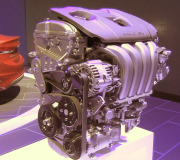That's a new one on me. Is the trunk open?
The reason I asked about the codes is they can lead you to the circuit or system with a problem, not necessarily the bad part. Any problem detected by the engine computer that could adversely affect tail pipe emissions will turn on the Check Engine light. There can be other fault codes stored in memory that don't result in the light turning on, but they could still provide clues, if they exist.
It is not common on '96 and newer cars to have a misfire or stalling problem that isn't picked up by the Engine Computer. By the way, I reread back to your original post and noticed you found no voltage to the fuel pump. Some clarification might be in order to prevent you from "getting wrapped around the axle". There are only two times you should have voltage to the pump. It will be there for one second after turning on the ignition switch to "run", then it will go back off. The voltage will reappear when the engine is rotating, (cranking or running). When pulses are received from the crankshaft position sensor and the camshaft position sensor, the Engine Computer turns on the Automatic Shutdown (ASD) relay. That relay sends battery voltage to the injectors, coil(s), oxygen sensor heaters, alternator field, and fuel pump or pump relay.
The fact that the engine was running is proof the fuel pump was running and the ASD relay was on.
I can suggest two things, ... Ok, three things. I hate blindly throwing parts at a car in hopes one sticks and fixes the poblem, but stalling when accelerating could be caused by a failing MAP sensor. They will not cause rough running on their own, but they have the biggest say in how much fuel the Engine Computer commands from the injectors. If the MAP sensor is reporting incorrectly that the engine is idling / not under load, the injectors won't spray enough fuel. Fuel starvation could cause the engine to stumble, stall, or just have low power. The sensor is powered by 5.0 volts. The acceptable range for its signal wire is between.5 and 4.5 volts. Anything outside that range will tell the computer to set a code and turn on the Check Engine light. Once that happens, the computer knows it can't trust the reading, so it disregards it and chooses an approximate value to run on based on pre-programmed values that correspond with readings from the other engine sensors. It will not run well, but it will run.
As long as the MAP sensor's values are within the acceptable range, the Engine Computer will believe them and not set a fault code. If the sensor is starting to fail, its reading could be wrong, but acceptable to the computer. One common clue years ago was the engine would run as long as the gas pedal was in motion. It didn't matter how far the pedal was pressed, as long as you kept moving it up and down, you could drive it into the shop.
The only system not monitored by the Engine Computer is the fuel supply system. Chrysler has always had very little trouble with their fuel pressure regulators, but if pressure is low, there will be running problems. If the engine is idling roughly while you're under the hood, remove the vacuum hose from the pressure regulator on the fuel rail and block the hose. Alternately, you can try to pinch the fuel return hose to the tank. That's the smaller of the two hoses. Either of those tricks will cause pressure to increase significantly. You can expect black smoke out of the tail pipe because too much fuel will be entering the engine, but if it smooths out, look for a fuel-related problem.
If there were a fault code related to a specific cylinder misfire, I would suggest swapping coils around if you have the individual coil-on-plug coils, then see if the code changes to a different cylinder misfire. Chrysler rarely has an injector problem, but you could also swap them when the computer tells you which cylinder is misfiring. I don't think a misfire is the problem though, as it would still accelerate without stalling.
If raising fuel pressure has no affect, I would try a MAP sensor next, (a cheap salvage yard one), as a test. If that doesn't help, see a mechanic who will connect a hand-held computer, called a scanner, to the car. It will read any stored fault codes, AND it will display real-time sensor voltages as the engine is running. He might be able to pick out one that is not responding correctly.
Caradiodoc
Friday, August 16th, 2019 AT 12:05 PM
(Merged)




